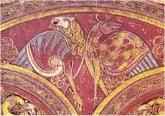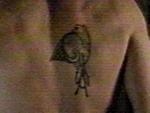ngel has a beautiful tattoo on his right shoulder blade of a large Gryphon holding the letter "A". It’s similar to the type of drawing once used in texts for the first letter of a paragraph or page back in the day when books were done by hand and many were true works of art. The Gryphon represents amongst other things, the duality of nature and the wealth of the sun. Just a bit of irony there.

The inspiration
for the tattoo seems to be from the Book of Kells. Where it is one of the four
traditional winged figures representing the Evangelists. It is the symbol for
Saint Mark; with the ox representing Saint Luke; the eagle,

It’s unlikely that Liam would have had an “A” tattooed on his back so chances are that Angelus had the tattoo done. Undoubtedly it stands for Angel although it could stand for Aurelius. Considering his first encounter with the Master that seems doubtful. However, nothing has been shown as to how or when the tattoo was done.
Who knows? Maybe Liam had too much to drink and was with a pretty girl whose name started with “A”? The question Buffy might ask is, since Giles found a reference to Angelus’ tattoo in a Watcher’s diary, how did a former Slayer see his naked back?

Joss Whedon had asked for a tattoo to be created for Angel. During the filming of the episode Angel, Joss was a little shocked and said that he had wanted a small tattoo such as shamrock or something of that size. However, he decided to keep the tattoo because he felt it suited Angel. Thank you Joss!

Take a look at the aspects of the Gryphon and the symbolism of Saint Mark and you might agree…
What is a Gryphon?
A Gryphon is a Chimerae; that is, a
blending of more than one animal. Gryphons are raptorine in the foreparts and leonine in the hind with
little exception. The typical Gryphon has an eagle
head, forelegs and wings, with a lion hind quarters, hind legs and tail.
Gryphons are fierce but solitary, at least with other species. They prefer
isolated areas, and live alone, but for other Gryphons.
Their trust is hard to earn, but once one has it, they are extremely loyal. Gryphons are not fearless, but they are very courageous.
Perhaps most important of all, they are not foolish. They are very wise beings.
Gryphons mate for life. Once they have chosen a mate, they are forever
faithful, and if the first mate dies, they will not take another.

The Gryphon in
Mythology
The Gryphon myth originates
somewhere in the Near or Middle East. It is found
depicted in ancient Babylonian, Assyrian, and Persian paintings and sculptures.
It is believed the myths found life around 3,000 B.C. to be the Pharoah's companion in Ancient Egypt, and later became
sacred guardians in Minoa.
Gryphons, like birds, built nests, or eyries
(aeries), as the nest of a bird of prey is called. The Gryphon laid an agate,
rather than an egg, therein. Gryphons found gold in
the mountains and made their nests from it.
This
made their eyries very tempting to hunters, so Gryphons were forced to keep vigilant guard over their
nests. Gryphons had instinct which allowed them to
know where buried treasure was, and they would apply themselves to guarding it
as best they could, keeping plunderers at distance.
They
are found in Greek mythology, neighbors of the Hyperboreans
and belonging to Zeus, they took gold from the stream Arimaspias,
the one-eyed people of
It
was written by Pomponius Mela,
that a certain area was uninhabitable, "because the Griffons (a cruel and
eager kind of wild beast) do wonderfully love the gold, which lies discovered
above the ground, and do wonderfully keep it, and are very fierce upon them
that touch it." Gryphons have always been
depicted as guardians of treasure. Gryphons
themselves depict gold, as they represent the wealth of the sun at dawn, the
gold in the east. They are also said to line their nests, called Eyries, with pure gold, woe be to the traveler looking to
steal it.
Romans
later used the Gryphon for decoration and in Christian times the Gryphon motif
appears.
In
Christian symbolism, the Gryphon originally represented Satan and evil, but
later came to represent Christ, especially his dual nature, both divine and
earthly, as the Gryphon had mastery of both land and sky, and was noble and
majestic. Gryphons were said to kill serpents and
basilisks, both embodiments of evil, thus protecting mankind. Gryphons symbolize both strength and wisdom combined in
heraldry. On medieval buildings, Gryphons were often
used as gargoyles, great stone guardians.
The
Gryphon has relinquished most of these roles, and today appears mostly in
literature and heraldry.
The Gryphon In Heraldry
Gryphons are often depicted in heraldry, such as a coat of arms or signs
by gates. Commonly, it is a demi-gryphon depicted...
a demi-gryphon is the head of the gryphon only. It is
distinguished from a raptor's head by the ears. The Gryphon above is a typical examble of a heraldic Gryphon; they are pictured as angular
and thinner, almost cheetah like.
The Gryphon in heraldry stands for many things. Commonly it stands for both Wisdom and Strength and the union of both. Gryphons also are a symbol against greed, as in mythology, they commonly guard gold or other treasures from greedy humans. Gryphons also represent the wealth of the sun -- the light that turns the east into gold at sunrise.
The Book of Kells
The Book of Kells
is a Latin text of the Gospels, and some other religious material, believed to
have been made by Irish monks on the Scottish
The symbolism of the winged lion of St
Mark is more complex. It represents one fourth of the nature of Christ. The man
being the human nature of Christ, the lion, the royal dignity; the ox, the
sacrifice, atonement and priesthood; and the eagle, the ascension and divine
nature. The lion is traditionally supposed to be roaring in the desert and
preparing the way. The four Cherubim guarding the throne of God and the Four
Corners of Paradise, are sometimes shown with four heads: human, lion, ox, and
eagle.
The winged lion can also represent the
union of two natures or the androgyne, and hence the
ultimate goal of alchemy, fire or the sun. And, like all composite beasts, it
suggests primordial chaos and the fearsome and terrifying powers of nature; and
the evil and chaotic forces in the world. While in Christian symbolism a lion
is considered to represent (as well as the majesty of Christ) the Devil, the
solitary hermit, and watchfulness and fortitude.
